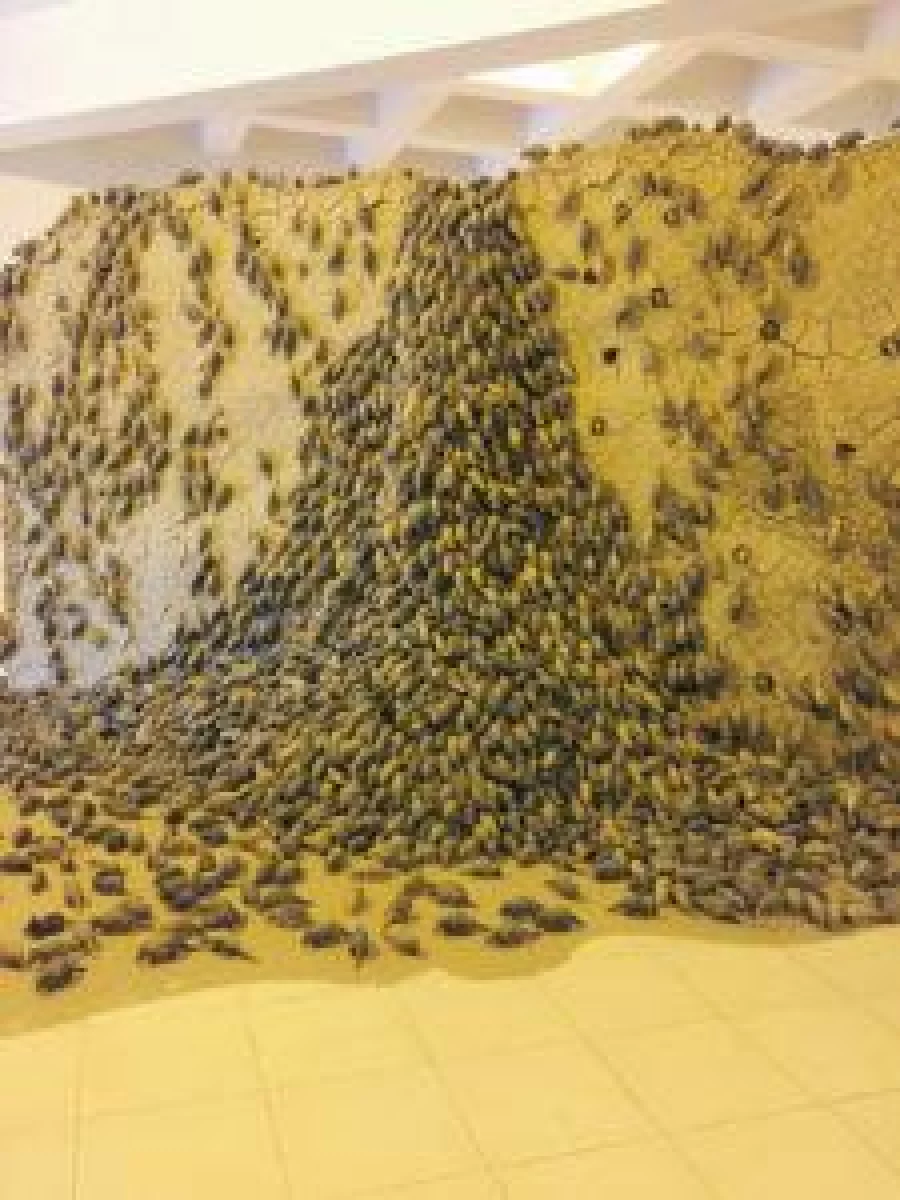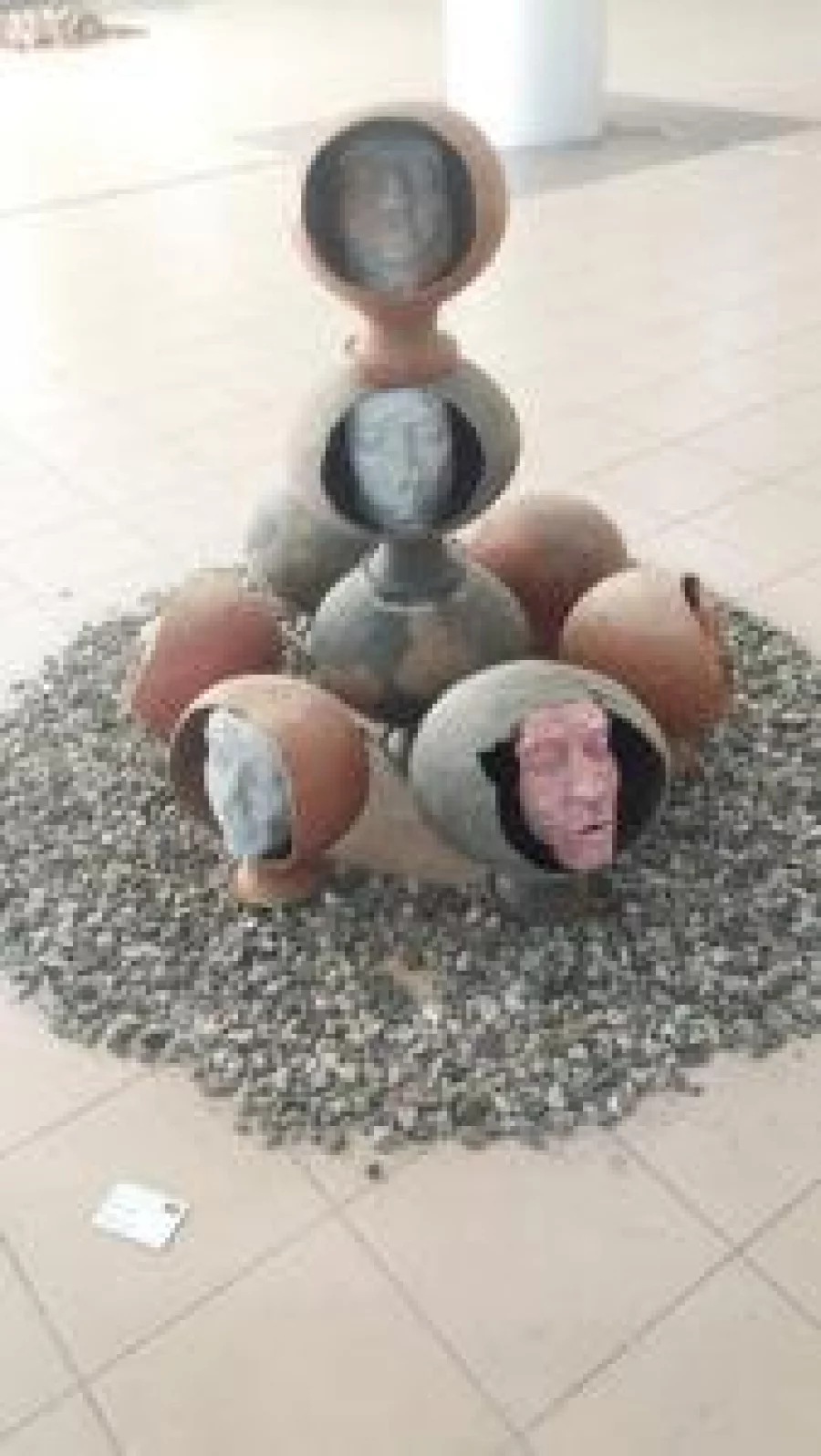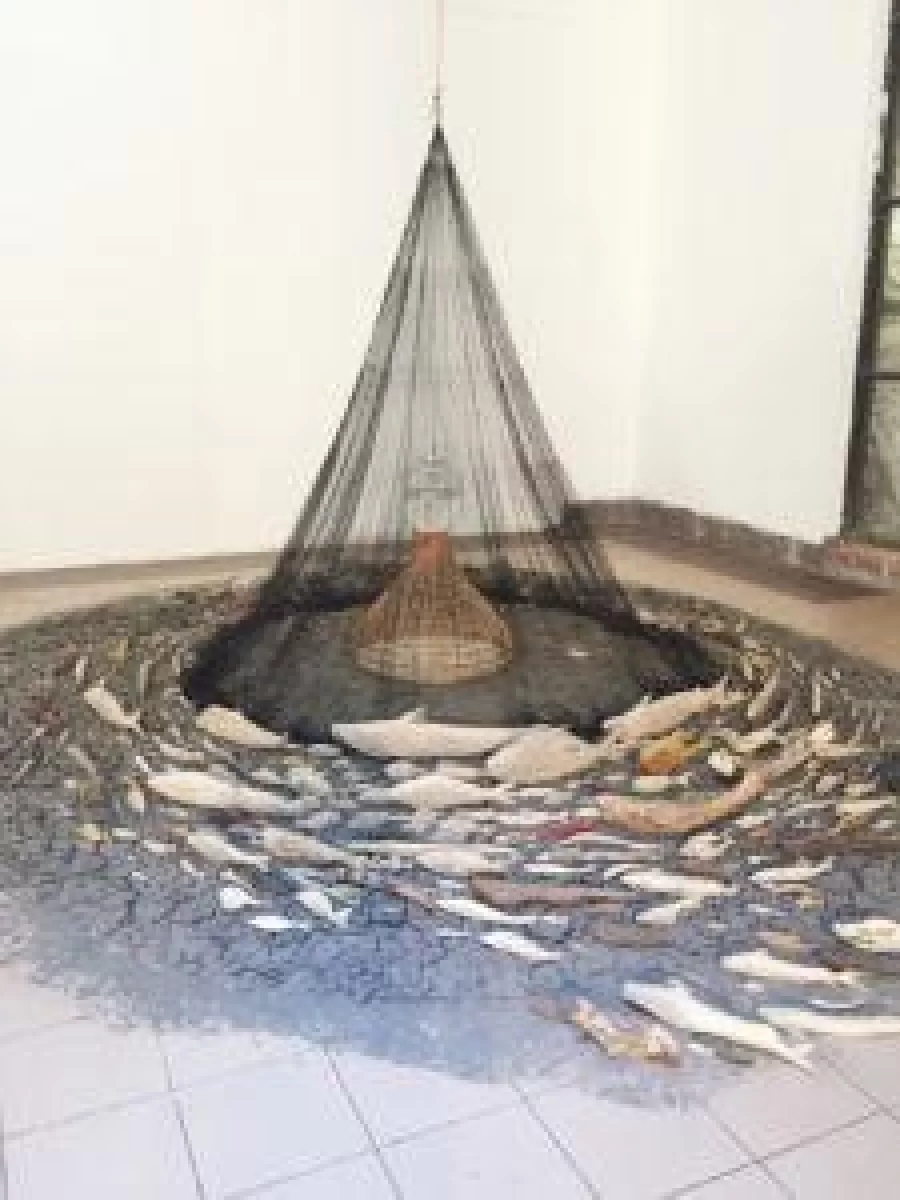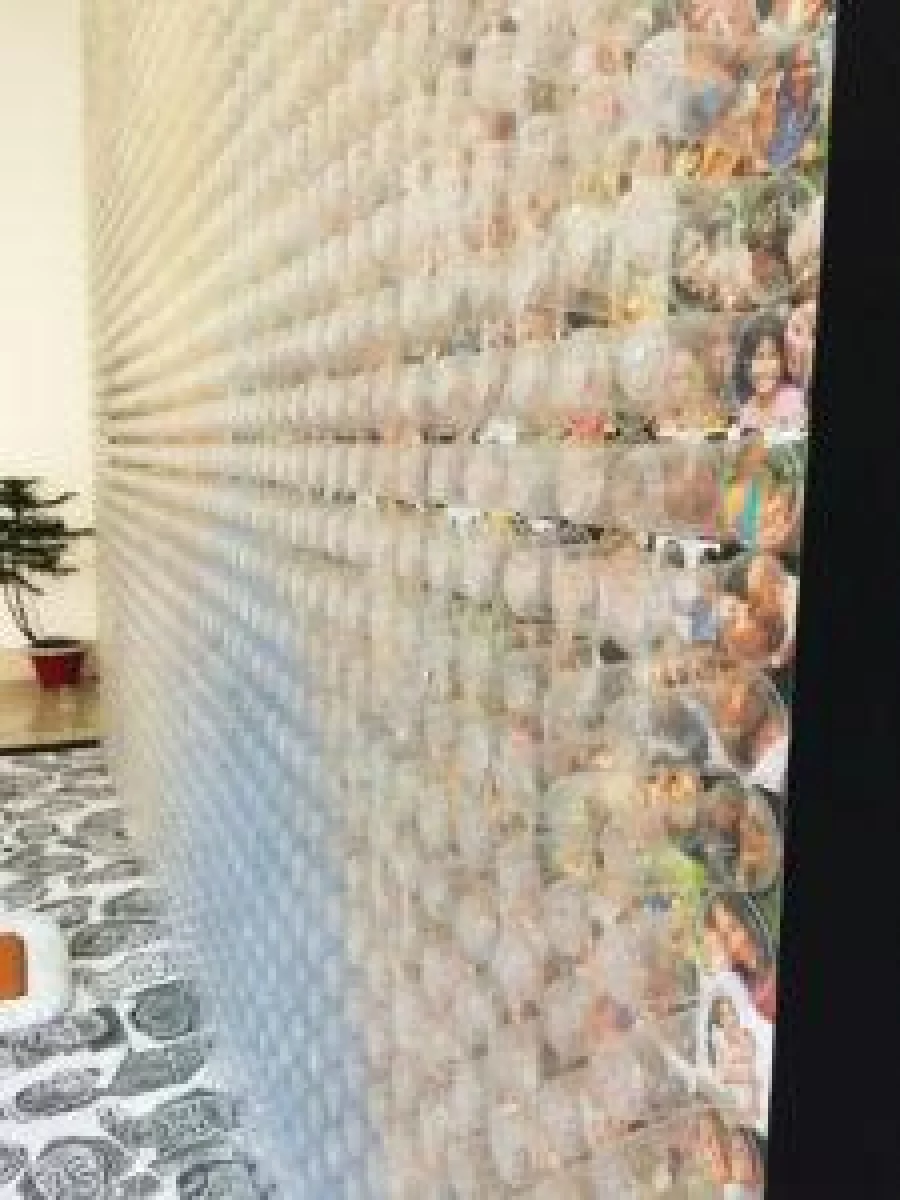This week saw the official opening of the 17th Asian Art Biennale in Bangladesh, and every nook and corner of the National Art Gallery Plaza of the Bangladesh Shilpakala Academy now holds a story of its own to tell through an incredibly diverse display of the arts. Dedicated to the memory of the renowned artist Qayyum Chowdhury, who passed away in 2014, this month-long art fiesta, which will end on December 31, 2016, has already attracted sizable crowds to the exhibitions.
The artists participating at the Biennale have, once again, surpassed themselves in experimenting with their work by pushing the boundaries of art and trying to express what not only words, but even paint and canvas, cannot. The great Edgar Degas once said, “art is not what you see, but what you make others see”. Today, we take a look quick at some of the installations featured at the Biennale that were not only beautiful to look at, but that made us uncomfortable, moved us in different ways and made us think.
The scourge of greed

It is no wonder that Kamruzzaman Shadhin was one of the three to win the Grand Prize at the 17th Asian Art Biennale – his colossus of cardboard coated with clay, with thousands of clay rats emerging and clambering over the installation, is horrid and fascinating at the same time. Titled 'Greed', the work is an ode to the excesses of human civilisation and the 'plastic illusion' of opulence that exists in our industrialised societies. According to the artist, “For a 'better life', to have more and more, we have engulfed ourselves in greed – greed that is so selfish, it eats up everything – forests, animals, oceans, air and even our own kind.”
The restless wave of time
The other Bangladeshi Grand Prize winner of the Biennale, Harun-ar-Rashid Tutul, has also portrayed the struggles and hypocrisies of human society, albeit in a very different way. The first impression you get from his installation is that of a low-budget theme park, with bumper cars in a darkened room driving against each other in loud music. Only they're not miniature cars, but busts of human heads, frantically and aimlessly clashing into each other, clambering to get across, on a background of news clippings that portray the insecurities of our daily lives, starting from rising militancy to unmitigated environmental risks. One cannot help but contemplate the chaos of the modern world, or the “divergence between the cherished social utopia and the actual social reality”, in the artist's words, when looking upon his work.
Eternal ringtones
While this installation didn't win a prize, Kazi Salahuddin Ahmed's creative construction of iron, net, glass and cement is one that will shake you to the core. On first glance it seems like nothing – a darkened room with all-too-familiar Nokia ringtone constantly ringing in the background. However, once you step inside and onto a pile of rubble, slipping over the uneven bricks with glass cracking under your feet, and see the video of bodies being pulled out from the Rana Plaza disaster, you realise the eternal ringtones symbolise all the calls from loved ones – calls that will forever remain unanswered. A beautiful and haunting tribute to the victims of the Rana Plaza tragedy.
For the women without words

In terms of paying tribute, Afsana Sharmin's installation also created a poignant effect while boldly talking about an urgent issue. Titled 'shadows on the light', the room that held her work carried with it a truly oppressive feeling – on one wall, there were faint, almost ghost-like cut-out outlines of women in black burkhas and on the other, screens that held a similar ghost-like quality, with women in burkhas speaking but their words becoming blurred. In the centre stood two figures robed in the dark garment from head to foot – testament to the invisibility and silence from women in burkhas who, whether in the pro or anti-camp, often have their voices ignored.
Gulshan Hossain also created an installation speaking out against violence against women, using the colour red, and light and glass to create a fascinating reflection of the human conscience when faced with such abused women. However, while Hossain's work mainly focused on the victimhood of gender-based violence, Sharmin did a marvelous job in bringing out issues of silence and agency in gender issues through her work.
Nature in a changing world

The 17th Asian Art Biennale is engaging not only because of the wide array of artwork on display but for the diverse issues that have been tackled through these expressions of art. This is most evident in the work of Md Abdul Momen Milton, who used mixed media and everyday rural tools, such as a fishing net, to talk about the very urgent issue of rivers running dry and fishermen losing their only means of subsistence. The clever use of water in a fishing bowl and the impressions of dry, cracking land around it, drove home a very clear message and can even seem a bit too obvious to some.
Soma Surovi Jannat also used natural material as well as other media to create a visual narrative in her work titled 'inverted space' depicting the Santhal community and the bond that they share with their land. However, while one appreciated the effort she put into creating a space that transports the viewer to another world, her rather over-simplified depiction of 'tribal' life came dangerously close to a one-dimensional portrayal of an indigenous community that whitewashes their history of struggle and the politics of violence that haunts them to this day.
On the other hand, MD Sanaullah's installation using only coconuts and other natural material, titled 'View of a journey', was mesmerising in its weirdness. While this writer cannot say with all certainty what you were meant to take from it, it reminded one of ghastly houses of otherworldly birds, among other things. Similarly, Zahida Akhter's clay heads in clay kalshis, titled 'Captives', also introduced a similar feeling of horrified curiosity, making one think of lost faces of lost civilisations, hiding within the bits and pieces they left behind.

Mixed media madness

In terms of using a variety of media in their artwork, Shyamol Chandra Sarker definitely took the lead with his representations of a horse using iron junk, cat using stainless steel parts, dog using copper utensils and deer using aluminium parts of machinery. His inventiveness and originality earned him an Honourable Mention Award at the 17th Asian Art Biennale. According to the artist, “it has been said – look at the condition of animal and environment if you want to know about the citizens of a nation. I believe my installation work will foster that message in particular.”
Two other installations that also won Honourable Mention Awards were - 'the roads of Dhaka' by Kuntal Barai, a delightfully mesmerising piece that experimented with a wide range of media to create a visual experience of Dhaka traffic, and is probably the only time you will be willing to listen to the incessant honking of cars; and 'Globalisation of Politics' by Rajib Kumar Roy, which imposed the greatest tragedies of the civilised world – war, terrorism, commercialisation of religion – onto the bioscope, something we generally associate with childhood mirth and simplicity.
Although he didn't win any awards this year, Uttam Kumar Roy's piece titled 'Ma, amar ma' also effortlessly combined a variety of media to create a beautiful piece – a collage of pictures of mothers with their children from all across the world, coming together to create a touching portrait of his own mother.
 It is no wonder that Kamruzzaman Shadhin was one of the three to win the Grand Prize at the 17th Asian Art Biennale – his colossus of cardboard coated with clay, with thousands of clay rats emerging and clambering over the installation, is horrid and fascinating at the same time. Titled 'Greed', the work is an ode to the excesses of human civilisation and the 'plastic illusion' of opulence that exists in our industrialised societies. According to the artist, “For a 'better life', to have more and more, we have engulfed ourselves in greed – greed that is so selfish, it eats up everything – forests, animals, oceans, air and even our own kind.”
It is no wonder that Kamruzzaman Shadhin was one of the three to win the Grand Prize at the 17th Asian Art Biennale – his colossus of cardboard coated with clay, with thousands of clay rats emerging and clambering over the installation, is horrid and fascinating at the same time. Titled 'Greed', the work is an ode to the excesses of human civilisation and the 'plastic illusion' of opulence that exists in our industrialised societies. According to the artist, “For a 'better life', to have more and more, we have engulfed ourselves in greed – greed that is so selfish, it eats up everything – forests, animals, oceans, air and even our own kind.” In terms of paying tribute, Afsana Sharmin's installation also created a poignant effect while boldly talking about an urgent issue. Titled 'shadows on the light', the room that held her work carried with it a truly oppressive feeling – on one wall, there were faint, almost ghost-like cut-out outlines of women in black burkhas and on the other, screens that held a similar ghost-like quality, with women in burkhas speaking but their words becoming blurred. In the centre stood two figures robed in the dark garment from head to foot – testament to the invisibility and silence from women in burkhas who, whether in the pro or anti-camp, often have their voices ignored.
Gulshan Hossain also created an installation speaking out against violence against women, using the colour red, and light and glass to create a fascinating reflection of the human conscience when faced with such abused women. However, while Hossain's work mainly focused on the victimhood of gender-based violence, Sharmin did a marvelous job in bringing out issues of silence and agency in gender issues through her work.
In terms of paying tribute, Afsana Sharmin's installation also created a poignant effect while boldly talking about an urgent issue. Titled 'shadows on the light', the room that held her work carried with it a truly oppressive feeling – on one wall, there were faint, almost ghost-like cut-out outlines of women in black burkhas and on the other, screens that held a similar ghost-like quality, with women in burkhas speaking but their words becoming blurred. In the centre stood two figures robed in the dark garment from head to foot – testament to the invisibility and silence from women in burkhas who, whether in the pro or anti-camp, often have their voices ignored.
Gulshan Hossain also created an installation speaking out against violence against women, using the colour red, and light and glass to create a fascinating reflection of the human conscience when faced with such abused women. However, while Hossain's work mainly focused on the victimhood of gender-based violence, Sharmin did a marvelous job in bringing out issues of silence and agency in gender issues through her work. The 17th Asian Art Biennale is engaging not only because of the wide array of artwork on display but for the diverse issues that have been tackled through these expressions of art. This is most evident in the work of Md Abdul Momen Milton, who used mixed media and everyday rural tools, such as a fishing net, to talk about the very urgent issue of rivers running dry and fishermen losing their only means of subsistence. The clever use of water in a fishing bowl and the impressions of dry, cracking land around it, drove home a very clear message and can even seem a bit too obvious to some.
Soma Surovi Jannat also used natural material as well as other media to create a visual narrative in her work titled 'inverted space' depicting the Santhal community and the bond that they share with their land. However, while one appreciated the effort she put into creating a space that transports the viewer to another world, her rather over-simplified depiction of 'tribal' life came dangerously close to a one-dimensional portrayal of an indigenous community that whitewashes their history of struggle and the politics of violence that haunts them to this day.
On the other hand, MD Sanaullah's installation using only coconuts and other natural material, titled 'View of a journey', was mesmerising in its weirdness. While this writer cannot say with all certainty what you were meant to take from it, it reminded one of ghastly houses of otherworldly birds, among other things. Similarly, Zahida Akhter's clay heads in clay kalshis, titled 'Captives', also introduced a similar feeling of horrified curiosity, making one think of lost faces of lost civilisations, hiding within the bits and pieces they left behind.
The 17th Asian Art Biennale is engaging not only because of the wide array of artwork on display but for the diverse issues that have been tackled through these expressions of art. This is most evident in the work of Md Abdul Momen Milton, who used mixed media and everyday rural tools, such as a fishing net, to talk about the very urgent issue of rivers running dry and fishermen losing their only means of subsistence. The clever use of water in a fishing bowl and the impressions of dry, cracking land around it, drove home a very clear message and can even seem a bit too obvious to some.
Soma Surovi Jannat also used natural material as well as other media to create a visual narrative in her work titled 'inverted space' depicting the Santhal community and the bond that they share with their land. However, while one appreciated the effort she put into creating a space that transports the viewer to another world, her rather over-simplified depiction of 'tribal' life came dangerously close to a one-dimensional portrayal of an indigenous community that whitewashes their history of struggle and the politics of violence that haunts them to this day.
On the other hand, MD Sanaullah's installation using only coconuts and other natural material, titled 'View of a journey', was mesmerising in its weirdness. While this writer cannot say with all certainty what you were meant to take from it, it reminded one of ghastly houses of otherworldly birds, among other things. Similarly, Zahida Akhter's clay heads in clay kalshis, titled 'Captives', also introduced a similar feeling of horrified curiosity, making one think of lost faces of lost civilisations, hiding within the bits and pieces they left behind.
 In terms of using a variety of media in their artwork, Shyamol Chandra Sarker definitely took the lead with his representations of a horse using iron junk, cat using stainless steel parts, dog using copper utensils and deer using aluminium parts of machinery. His inventiveness and originality earned him an Honourable Mention Award at the 17th Asian Art Biennale. According to the artist, “it has been said – look at the condition of animal and environment if you want to know about the citizens of a nation. I believe my installation work will foster that message in particular.”
Two other installations that also won Honourable Mention Awards were - 'the roads of Dhaka' by Kuntal Barai, a delightfully mesmerising piece that experimented with a wide range of media to create a visual experience of Dhaka traffic, and is probably the only time you will be willing to listen to the incessant honking of cars; and 'Globalisation of Politics' by Rajib Kumar Roy, which imposed the greatest tragedies of the civilised world – war, terrorism, commercialisation of religion – onto the bioscope, something we generally associate with childhood mirth and simplicity.
Although he didn't win any awards this year, Uttam Kumar Roy's piece titled 'Ma, amar ma' also effortlessly combined a variety of media to create a beautiful piece – a collage of pictures of mothers with their children from all across the world, coming together to create a touching portrait of his own mother.
In terms of using a variety of media in their artwork, Shyamol Chandra Sarker definitely took the lead with his representations of a horse using iron junk, cat using stainless steel parts, dog using copper utensils and deer using aluminium parts of machinery. His inventiveness and originality earned him an Honourable Mention Award at the 17th Asian Art Biennale. According to the artist, “it has been said – look at the condition of animal and environment if you want to know about the citizens of a nation. I believe my installation work will foster that message in particular.”
Two other installations that also won Honourable Mention Awards were - 'the roads of Dhaka' by Kuntal Barai, a delightfully mesmerising piece that experimented with a wide range of media to create a visual experience of Dhaka traffic, and is probably the only time you will be willing to listen to the incessant honking of cars; and 'Globalisation of Politics' by Rajib Kumar Roy, which imposed the greatest tragedies of the civilised world – war, terrorism, commercialisation of religion – onto the bioscope, something we generally associate with childhood mirth and simplicity.
Although he didn't win any awards this year, Uttam Kumar Roy's piece titled 'Ma, amar ma' also effortlessly combined a variety of media to create a beautiful piece – a collage of pictures of mothers with their children from all across the world, coming together to create a touching portrait of his own mother.

